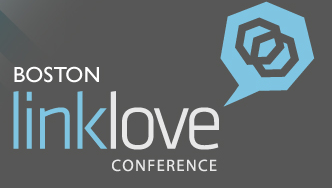 Good morning from Harvard Medical School! No, we haven’t changed careers, as much as our parents might like that. We’re here for LinkLove, and if you know anything about Distilled conferences, you know today is going to be chock full of fantastic, actionable information. If you don’t implement at least a few of the tips we’ll cover today, you’ll be missing out. So no sitting back and relaxing. Get ready to take notes, and keep an eye on the blog because we’re about to get busy!
Good morning from Harvard Medical School! No, we haven’t changed careers, as much as our parents might like that. We’re here for LinkLove, and if you know anything about Distilled conferences, you know today is going to be chock full of fantastic, actionable information. If you don’t implement at least a few of the tips we’ll cover today, you’ll be missing out. So no sitting back and relaxing. Get ready to take notes, and keep an eye on the blog because we’re about to get busy!
First up is Rand Fishkin.
Rand warns us that his slides are on a bit of a different topic than link building. The title is F#$%! Link Building. Content Marketing FTW. He says he spent a lot of time banging his head against a wall trying to get links when he first started out.
He talks about the e-mails he sent out that didn’t get any response. Getting links is the “manual labor of the SEO world.” The process sucks. You’ve all done it, so you know, right? There are alternatives. Buying links, for one. And then you get burned by Google. In the last 60 days, 700k e-mails were sent from Google telling site owners their sites were banned.
What’s going on?
Why Links are in Danger
This process is broken. Everyone today is going to give you different ways to do stuff. My goal is to change how you think about link building in the first place.
When a blogger links to something, what he’s not saying is, Google please rank me higher than another page that talks about the same thing.
The algo was never intended to benefit marketers like us. But we’re the ones who are the best at this. Someone who doesn’t have an SEO background, or understand how search engines work aren’t going to be as good as we are, but that’s antithetical to what Google is supposed to be.
Google’s trying to move beyond links. We’ve been doing studies on this. Link signals used to be the most powerful ones. Over time, links are still very important, but there’s more sophistication, and more of other things mattering more than links, all kind of things Google says they have no control over, like Facebook shares. They don’t use open graph. But these things have a high correlation to rank.
Sharing on the Web has evolved. How many have heard of the linkerati? These few individuals who control the link graph. We can create link signals, but how many of us are there? About five percent? Not anymore.
Today, the Linkerati is a much bigger group. Networked creators are everywhere. Two thirds of adults, three quarters of teens.
Tactical SEO
Yes, link building is important, powerful, and it works. He’s not trying to say it never works. Even blackhat SEO works. But this is how you think of it. I want to rank higher for whatever your term is. You have two options:
Option A:
Create lots of great content, starts a blog, etc.
Option B:
Build some f#$%ing links to my site.
Let’s think about it more strategically, and go more big picture. What you really want is more people coming to your site, and to spend less time, money and energy bringing them there than your competitors do. If budget was unlimited, and people clicked on the paid results, it would be different. But if you invest in what we do, you get a lower cost of acquisition than your competitors.
If you do that, you can win a market.
SEOMoz has been trying to raise investment capital for years. While I can’t raise money for it, I can rank for it. (Ha ha!)
Why does he love content, social media, and all of this so much? Because most people who take a free trial of SEOMoz didn’t come through pay channels. They didn’t pay to acquire them. We blog, share, do SEO.
Decision Time
What do you want to do? Build some f#$%ing links? Or build some great content?
Five Reasons Rand Invests in Content vs. Links
- It helps with every single aspect of marketing. Doesn’t matter what you want to do. Content builds branding. Your costs will be lower because people will like you, will share you, and help build you up.
- To be proud of his work. When you’re trying to bring good people into the company, and they’re going to have to take a paycut to work at a startup, the way you attract them to leave their cushy day job is to inspire them. Tell them they’re going to work on something bigger than themselves. It’s tough to do that when you’re buying links.
- To have strategies that last no matter what. He’s talking about, what if the Web really changes? What if Google Plus is just the start. He thinks it is. What about duckduckgo.com? It’s brand controlled and human-edited.
- To build content links while he sleeps. He has an awesome button on his site. You should totally get it. Button says give me a link to your domain. Everyone should get this button. He goes to the SEOMz site to show us the button, and it is…he can’t log into his own site. He gets an invitation to sign up for SEOMoz. April Fool’s Day was yesterday, right?! Rand lets out an “Oh brother,” and gives up. So he just tells us, it’s the publish button. Every time they publish something on the SEOMoz site, they get thousands of links. Some are scraper sites, sure, but they get links. It scales, it works, and build links while you sleep.
- Because of what it does to build brand loyalty and trust. Then he plays a video on Vimeo. (I’ll have to see if I can get the link for you later.) It’s about a knife maker, and the process he goes through to make knives. Rand plays some of it and then says he doesn’t need a new kitchen knife, but after watching that video, he wants one of those knives! Just because of the way the guy presented his product.
So you’re sold, right? You need content. But what kind of content should you make?
Don’t limit yourself to content about your subject
Just because you’re an office supply company, doesn’t mean you have to write about office supplies. Find out what your audience cares about, who they are, and how they relate to your products, and that’s where your content comes from.
He shows us the Fiskars scissors Web site. Boring, right? But they have one of the most dynamic sites and communities on the Web. They have content coming from their audience every six hours that goes huge on the Web. They have one of the most active Facebook pages he’s ever seen. And it’s about scissors.
Brand your product to align with your content. When he says content, he could mean actual content. Or he could mean community. He’s talking about Etsy, dribble, and shitter.com where you can print out tweets you don’t like onto toilet paper. No, really. They don’t need a blog.
After LinkLove London, lots of blog posts appeared on the Web. Lots of people used his examples, so he wanted to change things up for Boston.
Content Brainstorming and Concepts for Your Web Sites
After landing in Boston, he tweeted, “Going to do something unique at #LinkLove Boston. If you’re coming and have a site in need of content, let me know.”
One site that responded was thefedorastore.com. Rand says, “How f#$%ing cool is a fedora store?!” He brings the site up, and says he has a brand they may want to incorporate into their content marketing. And he brings up another video which is…Portlandia! (If you haven’t seen this show yet, you must check it out. It’s on Netflix. Seriously. Watch it.)
Rand says he thinks that’s their demographic. The people who want to buy their hats, and are hipsters, that’s their customer. He had some content ideas. He found an infographic calld This is a Hat Guide. It’s terrible. Worst. Infographic. Ever. Rand says, please tell me which hat I’m supposed to wear. That knowledge has died out! He brings up the Trustworthiness of Beards infographic, and says they can do that for hats.
Then go find people who wear hats, in public, who talk about it in social media, and talk to them. Rank them. Tell them they win the hat of the week award. Something.
Next site he brings up is needcaffeine.com. He says what he wants is a mini whiteboard that he keeps near his desk that tells him whether he’s had too much caffeine, not enough, whatever. Send it to a few people. Tweet it. Facebook it.
They can also do what Foursquare does. Track people who say they’ve gotten coffee, and rank them as having had the most caffeine. They can build an app for it. They could get so much press, it’s not even funny. They’re out of Chicago, so start tracking caffeine usage in Chicago, find patterns, publish research. There’s so much they can do.
They could also rate how much caffeine is in the most popular fast food coffee brands—Starbucks, McDonald’s, Dunkin, etc. Title it in SEO kinds of ways, which no one ever does they do those kinds of things.
Then, there are so many weird foods that contain caffeine, like chocolate, berries, foods no one knows about. Make a list.
The best part of all of this…
He came up with all of these ideas in a two-hour period with little sleep after flying in from London and being jetlagged. Imagine what you could do with eight hours of sleep!
You heard him. Get to it!
Be sure to catch all of our LinkLove Boston liveblogging coverage right here on the Outspoken Media blog!

